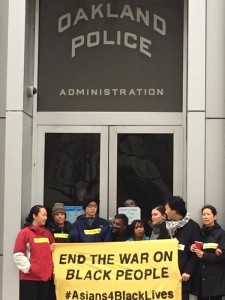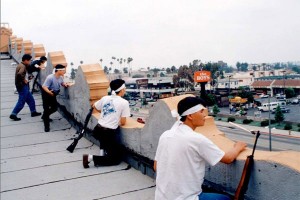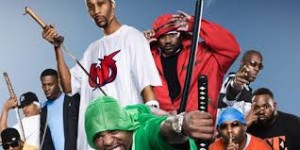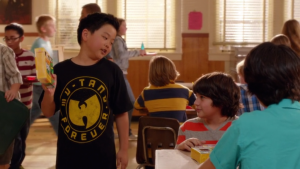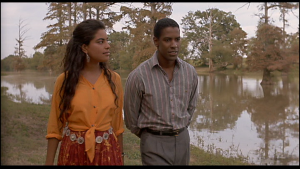In the wake of the recent murders of Michael Brown, Eric Garner, and Tamir Rice, Asian Americans have joined in solidarity with African Americans to confront race-based police brutality. The group #Asians4BlackLives has mobilized Asian allies – and on December 14, 2014 it supported the “ The Blackout Collective” to occupy the Oakland Police Department.
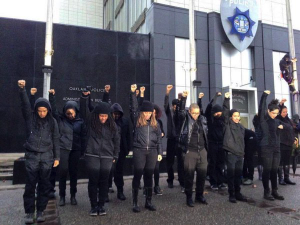
This act of solidarity against the police is profound given the historical tensions between Asians and African Americans in the US, especially in California. For the cross-racial animosity during the 1992 LA uprising, following the non-indictment of the police officers that brutally beat Rodney King, remains a seminal moment of division between the two groups. Media footage of the media-dubbed “riots” showcases African Americans looting and destroying businesses in LA’s Koreatown, with Asian shop owners taking up arms when the L.A.P.D did not respond to their calls for help. TV screens were saturated with images of African Americans breaking shop windows and setting stores ablaze, while Koreans shot their pistols and rifles in self-defense.
Without adequate historical context, news outlets exacerbated longstanding misunderstandings between the two groups. Far from being the result of inherent cross-racial biases or prejudices, the violence between African and Korean Americans during the uprising was rooted in the construction of the “model minority” stereotype, a direct result of immigration policy that created competition between peoples of color.
Nearly 30 years before the uprising, the U.S. opened its borders to East and South Asians after a longstanding population quota against these groups. The 1965 Immigration and Nationality Act let Asians and their families into the United States with the stipulation that these new immigrants had to be educated professionals. They were not from their home country’s working class, nor were they disenfranchised refugees. The aim of the Act was to stimulate the U.S. economy while providing first-world opportunities to these new migrants. Unlike the European immigrants who came before, these new immigrants had financially promising skill sets from the start. As Vijay Prashad points out in his book The Karma of Brown Folk, this new minority class was designed to provide solutions for American issues – racial and economic – not compound its problems. Therefore the Asians of ‘65 were not just a new group of minority immigrants, but would become new and model class of minorities – formally educated, economically independent, well behaved, and family oriented.
That the “model minority” class of immigrants began its construction at the height of the African American struggles for desegregation – the same year of the Civil Rights Voting Act and assassination of Malcolm X – is symbolic of the divisions that were bound to arise between people of color in the United States. One group was given open opportunity and another was struggling for that same opportunity — and interacted in very close quarters. Because of a language barrier, as was the case with new Koreans, many new Asian immigrants in the 1960s, 1970s, 1980s were unable to get jobs in their preferred fields of science and engineering (see the film, Clash of Colors). Instead, they established businesses in what were affordable areas to them, but where many white Americans refused to set up shop – impoverished and predominately African American. However, with little to no knowledge of U.S. race relations, in the words of Prashad in his book Everybody Was Kung Fu Fighting: Afro-Asian Relations and the Myth of Cultural Purity: “they were unaware of the political powder keg they were about to ignite” (155).
African American resistance to these new Asian businesses was strong. Many Koreans worked in black areas, but resided elsewhere. Their language barrier was seen as a refusal to learn the language of the community. As a result, African Americans saw that they did not integrate or support the communities that they served – all while many African Americans were not financially able to own businesses their own communities because of structural poverty. Black New York newspaper The Amsterdam News ran headlines that warned African Americans of “Korean Invasion” and Spike Lee dramatized black and Korean tensions in his 1989 film, Do the Right Thing. In 1990, the Black Nationalist lead “Flatbush Boycott” ran a campaign against Korean shop owners in Brooklyn. On the West Coast, the LA Sentinel ran similarly discriminatory headlines in the late ’80s and in 1991 Ice Cube released the song “Black Korea” in which he rapped a startling premonition: “Every time I wanna go get a fuckin brew/I gotta go down to the store with the two/oriental one-penny countin motherfuckers…So don’t follow me, up an down your market/Or your little chop suey ass’ll be a target/of the nationwide boycott/ Juice with the people, that’s what the boy got/So pay respect to the black fist/or we’ll burn your store, down to a crisp.” Black/Korean tensions on the West Coast came to a head when, just 13 days before the Rodney King beating, 15 year old African American teenager Latasha Harlins was shot and killed by 51 year old Korean shop owner Joon Ja Du who accused the young girl of stealing orange juice. In this context, the violence between Asians and blacks during the 1992 uprising seemed inevitable. However, it is important to remember that the problem between African Americans and Koreans at that time was not solely one of attitude or stereotype but, in Prashad’s words, “a fundamental flaw in the social relations between people” (116). There have been political forces that created these divisions. After all, a “model minority” class of color implies that there was and is a class of color that needs a model to follow.
Black-Asian relations in the 1990s were not all tense, however. Indeed, a recent NPR report found that during the final days of the “riots,” Koreans in L.A. began to make concerted efforts to reconcile with the African American community it served.
With the expansion of the 1965 Immigration Act in 1990, came more opportunity for productive cross-racial and cross-cultural exchange. For example, in The Tao of Wu, Wu Tang Clan member RZA recounts the long afternoons he spent watching Ku Fu Movies at the $2 Asian theatres in New York (47). His time immersed in Asian cinema had a direct impact on his creative aesthetic and spiritual philosophy.
In turn, music producer Sophia Chang recalls that she shied away from her Asian heritage until she signed a Kung Fu loving hip hop tro named Fu-Shnickens and later met Wu Tang. She writes: “I was a second-generation Korean Canadian who lost her language and ate cheeseburgers while the rest of the family feasted on kalbi and banchan. In 1992, my racial and cultural denial was alive and kicking. It wasn’t until I met Wu-Tang that…my belated ‘Asian Renaissance’ started”. Eddie Huang, too, has used hip-hop to help negotiate his place in the United States as a child of Chinese immigrants. His memoir Fresh off the Boat (now a television show) recounts the impact of 1990s hip-hop as he navigated assimilation and oftentimes devastating home life. It is no wonder that he is good friends, now, with Ta-Nehisi Coates. And as early as 1991 director Mira Nair released Mississippi Masala, a film that dramatized a complex love affair between the daughter of African-Indian immigrants who run a liquor store and a young Southern black man with his own carpet cleaning company.
The impact of black culture and thought on Asian-Americans and vice versa cannot be underestimated. As #Asians4BlackLives makes clear, important alliances are imminent. —Rebecca Kumar
